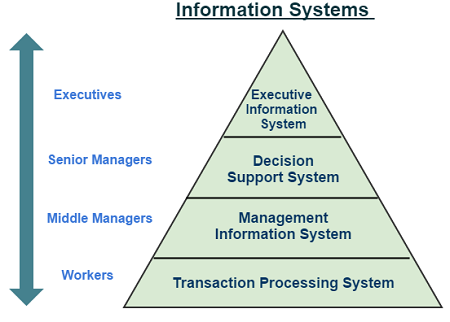What is an Information Systems and Types of Information Systems?
Information system is a collection of hardware, software, infrastructure and trained personnel which are going to do easy planning to make reliable infrastructure, control, coordination between software and hardware and decision making in an organization. As we all know Organization work with the large amounts of data and data is nothing but the basic value or facts which are organized in a database. Data is not synchronous with the information. However, information actually consist of data that has been organized and going to help to solve problems. It is defined as a software that helps, organize and analyse data. So the main purpose it serve is to turn raw data into an information which is useful and can be used by any organization for decision making.

Types of Information systems
Decision Support Systems
Decision support system is a computerized information or computer program application which support a business information so that user can easily get those information of the organization those are decision making activities. It intended to help decision makers to compile relevant information from the raw data, personal knowledge, documents to identify and solve the user problem and make decision regarding to information which is sometimes also called interactive knowledge-based system.
We used term information above so what information that decision support application gather and how would be present are: Access all the current information assets which include legacy, relational data source, cubes, data warehouse and marts. Figure out the comparative sales between the weeks.
Transaction Processing Systems
This is an information system which collect, receives, modifies, and store the information or data transaction of an enterprise same as in any store where user take products from shelves and staff is taking items from the stock and placing in the shelves. So all the events and the related are referred as Transaction. Events of transaction follow ACID test in which data is generated and modified before stored in information system. Success of an enterprise depends on the processing of transaction to ensure customer product should be delivered on time and partners are paid and can make payments.
Management Information Systems
Management Information System is abbreviated as MIS is a computer based system. To the mangers it is organizational system and procedure and for the programmers it is file structure and processing which involves more complexity. MIS emphasis of three components management having a user with the decision making power, Information having processed data and System which integrate the combination of both or the entire view. Some of the features if MIs are long term planning, provide dynamic structure of the organization, Behave like a complete system which cover all interconnected subsystems in the organization, provide linkage between the interconnected sub-systems so that they take decision on the integrated view, allow easy flow between sub-systems of the information thus avoiding redundancy and duplicate data.
Expert Systems and Neutral Networks
Both of the type of system have been a huge help to many business and also help to make decisions. How they differ in working, and how you get decision from them. Expert system works by user putting data into user interface which cause system to go and try to find out appropriate data. The information needed for the decision is acquire by inference engine work with knowledge acquisition tools. How they work, once the information is found firstly it analysed and put the data into knowledge base and then it turn back around on user interface so that user can see the processed information by the system and they make decision based on knowledge as an expert of a field. Neutral network is same like other network but a non-liner data model. How they work, first the information is inputted to the network to analyze and similarities are found from the inputted information. After that decision to be made from that information. But it make decision from the previous patterns and I/O.


